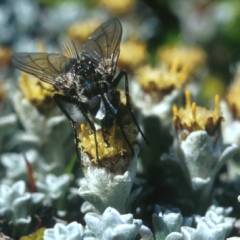Dr Robert McKenzie
Contact:
Department of Plant and Microbial Sciences,
University of Canterbury,
Christchurch
Collaborators:
Dr. Josephine Ward (University of Canterbury)
Dr. Ilse Breitwieser (Landcare Research)
My principal research interests are hybridisation, breeding systems and insect pollination and their influence on the evolution of the New Zealand flora. Information on reproductive biology is important for understanding evolutionary relationships, yet surprisingly few such studies of native plants have been published.

For my Ph.D. and postdoctoral research I have been studying the New Zealand paper daisies (members of the family Compositae, tribe Gnaphalieae). This group includes some of our most distinctive alpine plants, such as the famous vegetable sheep and the New Zealand edelweiss. The group exemplifies characteristics of many species complexes in the New Zealand flora: recent extensive adaptive radiation, generating incredible morphological and ecological diversity, but less diversity in conservative genetic regions; poorly defined generic boundaries and incomplete reproductive barriers between species; a generalist pollination system and pollination by unspecialised insects (e.g., native solitary bees, flies and moths). Of particular interest is the occurrence of natural intergeneric hybrids in this group, but most of these hybrids are unsubstantiated by published evidence. In the past the hybrids have been considered botanical novelties, but my research has shown that some could be important in the
future evolution of the New Zealand paper daisies.
I am utilising multivariate analysis of morphological data and isozyme electrophoresis to prove the existence of natural intergeneric hybrids. An extensive array of artificial pollinations provided evidence for the cross-compatibility of endemic representatives of six genera (Anaphalioides, Euchiton, Ewartia, Helichrysum, Leucogenes and Raoulia). Two exciting discoveries are the partial fertility of most of the intergeneric hybrids examined so far, and the occurrence of natural backcrosses and an advanced-generation hybrid between A. bellidioides and E. sinclairii. Thus, the hybrids may not be evolutionary 'dead-ends' but may facilitate gene exchange between the genera and ultimately may even give rise to new species. Insect visitors to the flowers of co-existing, hybridising species have been monitored at two localities to assess potential pollinators and the level of pollinator-mediated isolation of the parental species.
Future studies of the reproductive biology of the native paper daisies will help to provide a clearer picture of species relationships, generic limits and how the group has evolved. Analysis of meiotic pairing in natural and artificial hybrids will provide evidence for chromosomal and genomic affinities. Artificial pollinations will allow investigation of post-pollination barriers to hybridisation and help to identify the group's closest relatives abroad. A further aim is to utilise molecular markers to quantify the frequency of natural hybridisation and identify the factors that either promote or preclude hybridisation between co-existing species. The work will also help to establish the past and potential contribution of hybridisation to the evolution of the New Zealand paper daisies.

I am also keen to expand our knowledge of the reproductive biology of other New Zealand native plants, particularly the alpine flora, for which little is known. I would like to utilise molecular-genetic markers to investigate the contribution of past hybridisation events to the evolution of the flora and to assess the present-day importance of hybridisation. I am also interested in the relationship between breeding and pollination systems and the ability to establish in New Zealand after long-distance dispersal, and the role of breeding and pollination systems in the recent adaptive radiations in New Zealand.
|